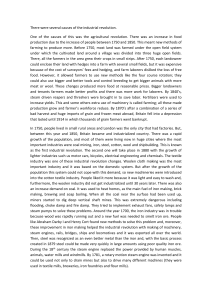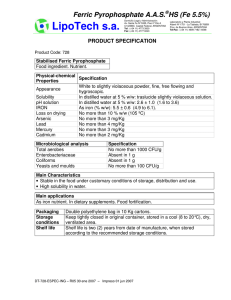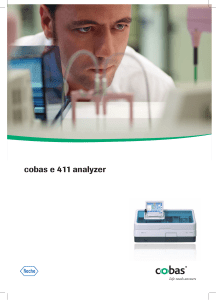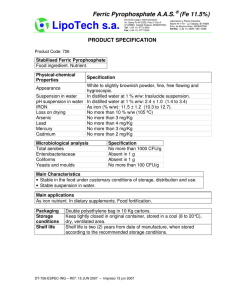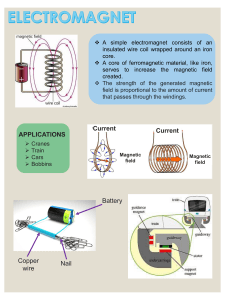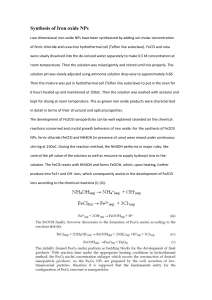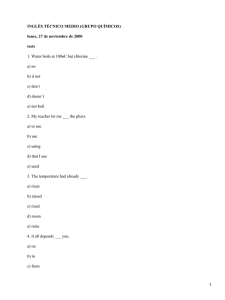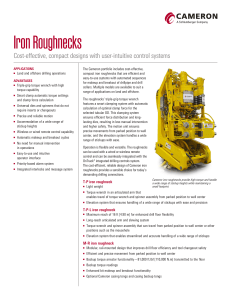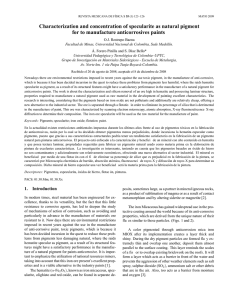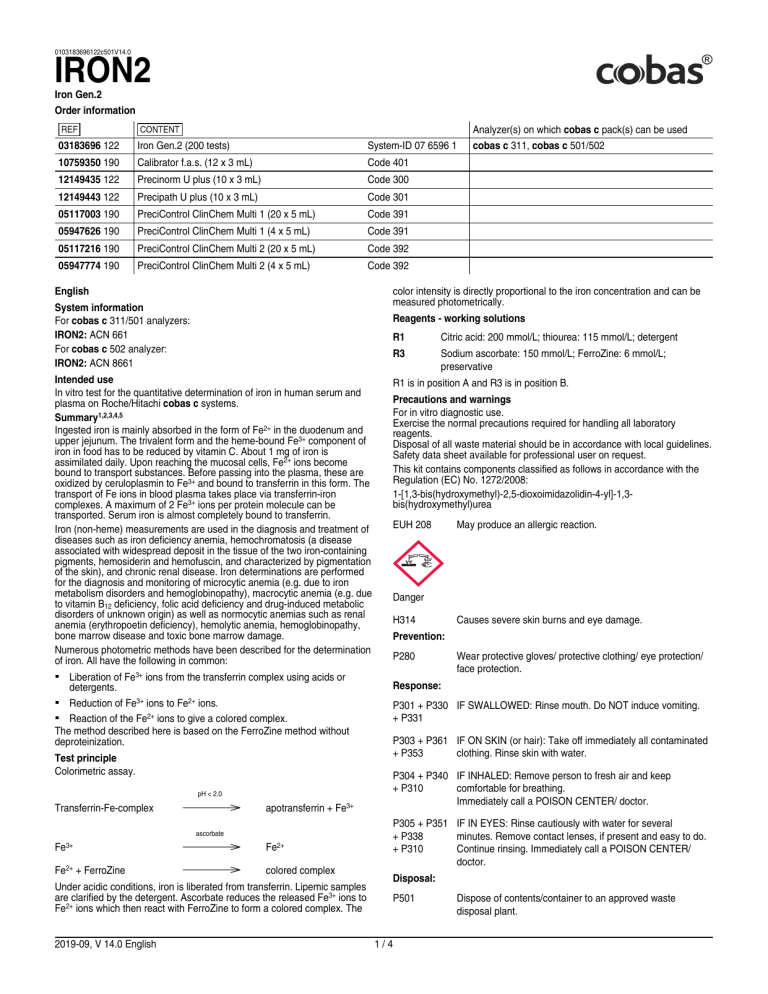
0103183696122c501V14.0 IRON2 Iron Gen.2 Order information Analyzer(s) on which cobas c pack(s) can be used 03183696 122 Iron Gen.2 (200 tests) System-ID 07 6596 1 10759350 190 Calibrator f.a.s. (12 x 3 mL) Code 401 12149435 122 Precinorm U plus (10 x 3 mL) Code 300 12149443 122 Precipath U plus (10 x 3 mL) Code 301 05117003 190 PreciControl ClinChem Multi 1 (20 x 5 mL) Code 391 05947626 190 PreciControl ClinChem Multi 1 (4 x 5 mL) Code 391 05117216 190 PreciControl ClinChem Multi 2 (20 x 5 mL) Code 392 05947774 190 PreciControl ClinChem Multi 2 (4 x 5 mL) Code 392 English color intensity is directly proportional to the iron concentration and can be measured photometrically. System information For cobas c 311/501 analyzers: IRON2: ACN 661 For cobas c 502 analyzer: IRON2: ACN 8661 Reagents - working solutions Intended use In vitro test for the quantitative determination of iron in human serum and plasma on Roche/Hitachi cobas c systems. Summary1,2,3,4,5 Ingested iron is mainly absorbed in the form of Fe2+ in the duodenum and upper jejunum. The trivalent form and the heme-bound Fe3+ component of iron in food has to be reduced by vitamin C. About 1 mg of iron is assimilated daily. Upon reaching the mucosal cells, Fe2+ ions become bound to transport substances. Before passing into the plasma, these are oxidized by ceruloplasmin to Fe3+ and bound to transferrin in this form. The transport of Fe ions in blood plasma takes place via transferrin-iron complexes. A maximum of 2 Fe3+ ions per protein molecule can be transported. Serum iron is almost completely bound to transferrin. Iron (non-heme) measurements are used in the diagnosis and treatment of diseases such as iron deficiency anemia, hemochromatosis (a disease associated with widespread deposit in the tissue of the two iron-containing pigments, hemosiderin and hemofuscin, and characterized by pigmentation of the skin), and chronic renal disease. Iron determinations are performed for the diagnosis and monitoring of microcytic anemia (e.g. due to iron metabolism disorders and hemoglobinopathy), macrocytic anemia (e.g. due to vitamin B12 deficiency, folic acid deficiency and drug‑induced metabolic disorders of unknown origin) as well as normocytic anemias such as renal anemia (erythropoetin deficiency), hemolytic anemia, hemoglobinopathy, bone marrow disease and toxic bone marrow damage. Numerous photometric methods have been described for the determination of iron. All have the following in common: ▪ Liberation of Fe3+ ions from the transferrin complex using acids or detergents. ▪ Reduction of Fe3+ ions to Fe2+ ions. ▪ Reaction of the Fe2+ ions to give a colored complex. The method described here is based on the FerroZine method without deproteinization. Test principle Colorimetric assay. pH < 2.0 apotransferrin + Fe3+ Transferrin‑Fe‑complex ascorbate Fe3+ Fe2+ Fe2+ + FerroZine colored complex Under acidic conditions, iron is liberated from transferrin. Lipemic samples are clarified by the detergent. Ascorbate reduces the released Fe3+ ions to Fe2+ ions which then react with FerroZine to form a colored complex. The 2019-09, V 14.0 English cobas c 311, cobas c 501/502 R1 Citric acid: 200 mmol/L; thiourea: 115 mmol/L; detergent R3 Sodium ascorbate: 150 mmol/L; FerroZine: 6 mmol/L; preservative R1 is in position A and R3 is in position B. Precautions and warnings For in vitro diagnostic use. Exercise the normal precautions required for handling all laboratory reagents. Disposal of all waste material should be in accordance with local guidelines. Safety data sheet available for professional user on request. This kit contains components classified as follows in accordance with the Regulation (EC) No. 1272/2008: 1-[1,3-bis(hydroxymethyl)-2,5-dioxoimidazolidin-4-yl]-1,3bis(hydroxymethyl)urea EUH 208 May produce an allergic reaction. Danger H314 Causes severe skin burns and eye damage. Prevention: P280 Wear protective gloves/ protective clothing/ eye protection/ face protection. Response: P301 + P330 IF SWALLOWED: Rinse mouth. Do NOT induce vomiting. + P331 P303 + P361 IF ON SKIN (or hair): Take off immediately all contaminated + P353 clothing. Rinse skin with water. P304 + P340 IF INHALED: Remove person to fresh air and keep + P310 comfortable for breathing. Immediately call a POISON CENTER/ doctor. P305 + P351 IF IN EYES: Rinse cautiously with water for several + P338 minutes. Remove contact lenses, if present and easy to do. + P310 Continue rinsing. Immediately call a POISON CENTER/ doctor. Disposal: P501 1/4 Dispose of contents/container to an approved waste disposal plant. 0103183696122c501V14.0 IRON2 Iron Gen.2 Product safety labeling follows EU GHS guidance. Contact phone: all countries: +49-621-7590 Sample volumes Reagent handling Ready for use Normal Decreased Increased Storage and stability IRON2 Shelf life at 2‑8 °C: See expiration date on cobas c pack label. On‑board in use and refrigerated on the analyzer: 6 weeks Sample Sample dilution Sample Diluent (H2O) 8.5 µL – – 4.0 µL – – 8.5 µL – – cobas c 501 test definition Assay type 2‑Point End Reaction time / Assay points 10 / 34-42 Wavelength (sub/main) 700/570 nm When removing the cobas c pack from the instrument during use, please immediately store at 2‑8 °C. Reaction direction Increase Units µmol/L (µg/dL, mg/L) Do not shake the cobas c pack to avoid foaming. Reagent pipetting Specimen collection and preparation For specimen collection and preparation only use suitable tubes or collection containers. Only the specimens listed below were tested and found acceptable. Serum. Plasma: Li-heparin plasma. Do not use EDTA or oxalate plasma. Separate serum or plasma from the clot or cells within 1 hour. The sample types listed were tested with a selection of sample collection tubes that were commercially available at the time of testing, i.e. not all available tubes of all manufacturers were tested. Sample collection systems from various manufacturers may contain differing materials which could affect the test results in some cases. When processing samples in primary tubes (sample collection systems), follow the instructions of the tube manufacturer. Centrifuge samples containing precipitates before performing the assay. See the limitations and interferences section for details about possible sample interferences. R1 100 µL – R3 20 µL – Sample volumes Sample Sample dilution Sample Diluent (H2O) Normal 8.5 µL – – Decreased 4.0 µL – – Increased 8.5 µL – – Stability:6,7 Diluent (H2O) cobas c 502 test definition Assay type 2‑Point End Reaction time / Assay points 10 / 34-42 Wavelength (sub/main) 700/570 nm Reaction direction Increase 7 days at 15‑25 °C Units µmol/L (µg/dL, mg/L) 3 weeks at 2‑8 °C Reagent pipetting several years at (-15)‑(-25) °C Diluent (H2O) R1 100 µL – Materials provided See “Reagents – working solutions” section for reagents. R3 20 µL – Materials required (but not provided) ▪ See “Order information” section ▪ General laboratory equipment Assay For optimum performance of the assay follow the directions given in this document for the analyzer concerned. Refer to the appropriate operator’s manual for analyzer‑specific assay instructions. The performance of applications not validated by Roche is not warranted and must be defined by the user. Sample volumes Sample Sample dilution Sample Diluent (H2O) Normal 8.5 µL – – Decreased 4.0 µL – – Increased 17.0 µL – – Calibration Calibrators Application for serum and plasma S2: C.f.a.s. cobas c 311 test definition Assay type S1: H2O 2‑Point End Calibration mode Linear Calibration frequency 2‑point calibration Reaction time / Assay points 10 / 23-27 • after cobas c pack change Wavelength (sub/main) 700/570 nm • after 7 days on board Reaction direction Increase Units µmol/L (µg/dL, mg/L) • as required following quality control procedures Reagent pipetting Diluent (H2O) R1 100 µL – R3 20 µL – Calibration interval may be extended based on acceptable verification of calibration by the laboratory. Traceability: This method has been standardized against a primary reference material (SRM 937). 2/4 2019-09, V 14.0 English 0103183696122c501V14.0 IRON2 Iron Gen.2 Quality control For quality control, use control materials as listed in the "Order information" section. In addition, other suitable control material can be used. The control intervals and limits should be adapted to each laboratory’s individual requirements. Values obtained should fall within the defined limits. Each laboratory should establish corrective measures to be taken if values fall outside the defined limits. Follow the applicable government regulations and local guidelines for quality control. Calculation Roche/Hitachi cobas c systems automatically calculate the analyte concentration of each sample. Conversion factors: µmol/L x 5.59 = µg/dL µmol/L x 0.0559 = mg/L µg/dL x 0.179 = µmol/L µg/dL x 0.010 = mg/L Limitations - interference Criterion: Recovery within ± 10 % of initial value at an iron concentration of 26.9 µmol/L (150 µg/dL). Icterus:8 No significant interference up to an I index of 60 for conjugated and unconjugated bilirubin (approximate conjugated and unconjugated bilirubin concentration: 1026 µmol/L or 60 mg/dL). Hemolysis:8 No significant interference up to an H index of 200 (approximate hemoglobin concentration: 125 µmol/L or 200 mg/dL). Higher hemoglobin concentrations lead to artificially increased values due to contamination of the sample with hemoglobin-bound iron. Lipemia (Intralipid):8 No significant interference up to an L index of 1500. There is poor correlation between the L index (corresponds to turbidity) and triglycerides concentration. Drugs: No interference was found at therapeutic concentrations using common drug panels.9, 10 In patients treated with iron supplements or metal‑binding drugs, the drug‑bound iron may not properly react in the test, resulting in artificially low values. In the presence of high ferritin concentrations > 1200 µg/L the assumption that serum iron is almost completely bound to transferrin is not valid anymore. Therefore, such iron results should not be used to calculate Total Iron Binding Capacity (TIBC) or percent transferrin saturation (% SAT).11 In very rare cases, gammopathy, in particular type IgM (Waldenström’s macroglobulinemia), may cause unreliable results.12 For diagnostic purposes, the results should always be assessed in conjunction with the patient’s medical history, clinical examination and other findings. ACTION REQUIRED Special Wash Programming: The use of special wash steps is mandatory when certain test combinations are run together on Roche/Hitachi cobas c systems. The latest version of the carry‑over evasion list can be found with the NaOHD-SMS-SmpCln1+2-SCCS Method Sheets. For further instructions refer to the operator’s manual. cobas c 502 analyzer: All special wash programming necessary for avoiding carry‑over is available via the cobas link, manual input is required in certain cases. Where required, special wash/carry‑over evasion programming must be implemented prior to reporting results with this test. Limits and ranges Measuring range 0.90‑179 µmol/L (5.00‑1000 µg/dL, 0.05‑10.0 mg/L) Determine samples having higher concentrations via the rerun function. For samples with higher concentrations, the rerun function decreases the sample volume by a factor of 2.1. The results are automatically multiplied by this factor. Lower limits of measurement Lower detection limit of the test 0.90 µmol/L (5.00 µg/dL, 0.05 mg/L) 2019-09, V 14.0 English The lower detection limit represents the lowest measurable analyte level that can be distinguished from zero. It is calculated as the value lying 3 standard deviations above that of the lowest standard (standard 1 + 3 SD, repeatability, n = 21). Expected values13 Adults: 5.83‑34.5 µmol/L (33‑193 µg/dL) The concentration of iron in serum/plasma is dependent on ingestion of iron and is subject to circadian variations.14 Each laboratory should investigate the transferability of the expected values to its own patient population and if necessary determine its own reference ranges. Specific performance data Representative performance data on the analyzers are given below. Results obtained in individual laboratories may differ. Precision Precision was determined using human samples and controls in an internal protocol with repeatability (n = 21) and intermediate precision (3 aliquots per run, 1 run per day, 21 days). The following results were obtained: Repeatability Mean SD CV µmol/L (µg/dL) µmol/L (µg/dL) % Precinorm U 19.8 (111) 0.1 (0.6) 0.6 Precipath U 32.8 (183) 0.2 (1.1) 0.6 Human serum 1 11.3 (63.2) 0.2 (0.6) 1.3 Human serum 2 54.5 (305) 0.5 (3) 0.8 Intermediate precision Mean SD CV µmol/L (µg/dL) µmol/L (µg/dL) % Precinorm U 20.1 (112) 0.3 (2) 1.5 Precipath U 33.5 (187) 0.5 (3) 1.5 Human serum 1 11.8 (66.0) 0.2 (1.1) 1.8 Human serum 2 55.1 (308) 0.7 (4) 1.3 Method comparison Iron values for human serum and plasma samples obtained on a Roche/Hitachi cobas c 501 analyzer (y) were compared with those determined using the corresponding reagent on a Roche/Hitachi 917 analyzer (x). Sample size (n) = 85 Passing/Bablok15 Linear regression y = 1.002x + 0.290 µmol/L y = 1.000x + 0.367 µmol/L τ = 0.986 r = 1.000 The sample concentrations were between 3.50 and 162 µmol/L (19.6 and 906 µg/dL). References 1 Wick M, Pinggera W, Lehmann P, ed. Eisenstoffwechsel, Diagnostik und Therapie der Anämien. 3rd ed. Wien/New York: Springer Verlag 1996. 2 Bernat I. Eisenresorption. In: Bernat I ed. Eisenstoffwechsel. Stuttgart/New York: Gustav Fischer 1981;68-84. 3 Bernat I. Eisenresorption. In: Bernat I ed. Eisenstoffwechsel. Stuttgart/New York: Gustav Fischer 1981;36-37. 4 De Jong G, von Dijk IP, van Eijk HG. The biology of transferrin. Clin Chim Acta 1990;190:1-46. 5 Siedel J, Wahlefeld AW, Ziegenhorn J. A new iron ferrozine reagent without deproteinization. Clin Chem 1984;30:975 (AACC -Meeting Abstract). 3/4 0103183696122c501V14.0 IRON2 Iron Gen.2 6 Guder WG, Narayanan S, Wisser H, et al. List of Analytes; Preanalytical Variables. Brochure in: Samples: From the Patient to the Laboratory. Darmstadt: GIT-Verlag 1996. 7 Use of Anticoagulants in Diagnostic Laboratory Investigations. WHO Publication WHO/DIL/LAB/99.1 Rev. 2: Jan 2002. 8 Glick MR, Ryder KW, Jackson SA. Graphical Comparisons of Interferences in Clinical Chemistry Instrumentation. Clin Chem 1986;32:470-475. 9 Breuer J. Report on the Symposium “Drug effects in Clinical Chemistry Methods”. Eur J Clin Chem Clin Biochem 1996;34:385-386. 10 Sonntag O, Scholer A. Drug interference in clinical chemistry: recommendation of drugs and their concentrations to be used in drug interference studies. Ann Clin Biochem 2001;38:376-385. 11 Tietz NW, Rinker AD, Morrison SR. When Is a Serum Iron Really a Serum Iron? A Follow-up Study on the Status of Iron Measurements in Serum. Clin Chem 1996;42(1):109-111. 12 Bakker AJ, Mücke M. Gammopathy interference in clinical chemistry assays: mechanisms, detection and prevention. Clin Chem Lab Med 2007;45(9):1240-1243. 13 Löhr B, El-Samalouti V, Junge W, et al. Reference Range Study for Various Parameters on Roche Clinical Chemistry Analyzers. Clin Lab 2009;55:465-471. 14 Burtis CA, Ashwood ER, Bruns DE (eds.). Tietz Textbook of Clinical Chemistry and Molecular Diagnostics. 4th ed. St Louis, Missouri; Elsevier Saunders 2006;1190. 15 Bablok W, Passing H, Bender R, et al. A general regression procedure for method transformation. Application of linear regression procedures for method comparison studies in clinical chemistry, Part III. J Clin Chem Clin Biochem 1988 Nov;26(11):783-790. A point (period/stop) is always used in this Method Sheet as the decimal separator to mark the border between the integral and the fractional parts of a decimal numeral. Separators for thousands are not used. Symbols Roche Diagnostics uses the following symbols and signs in addition to those listed in the ISO 15223‑1 standard (for USA: see dialog.roche.com for definition of symbols used): Contents of kit Volume after reconstitution or mixing Global Trade Item Number GTIN COBAS, COBAS C, PRECINORM, PRECIPATH and PRECICONTROL are trademarks of Roche. All other product names and trademarks are the property of their respective owners. Additions, deletions or changes are indicated by a change bar in the margin. © 2019, Roche Diagnostics Roche Diagnostics GmbH, Sandhofer Strasse 116, D-68305 Mannheim www.roche.com 4/4 2019-09, V 14.0 English
